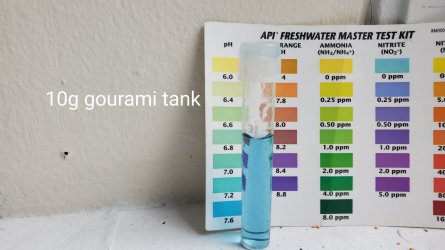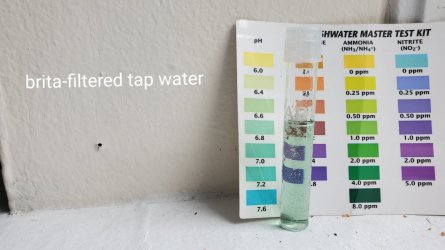These tests are for pH, not GH (or KH) so it would be best not to use the term "hard" until we know the GH. The question you need to ask of the water authority is how they are achieving a pH of 9. You should be able to get the GH of the water from them as well. Check if they have a website (Boston certainly should), this info may be there. I know New York City has very soft water, yours may be as well, which means they are adding something to increase the pH [this occurs with my water here] and once we know what it is, we will have a better idea of what if anything may be necessary.
You are using an out of date browser. It may not display this or other websites correctly.
You should upgrade or use an alternative browser.
You should upgrade or use an alternative browser.
Increased water pH shenanigans continues unabated
- Thread starter outofwater
- Start date
outofwater
Fish Addict
These tests are for pH, not GH (or KH) so it would be best not to use the term "hard" until we know the GH. The question you need to ask of the water authority is how they are achieving a pH of 9. You should be able to get the GH of the water from them as well. Check if they have a website (Boston certainly should), this info may be there. I know New York City has very soft water, yours may be as well, which means they are adding something to increase the pH [this occurs with my water here] and once we know what it is, we will have a better idea of what if anything may be necessary.
All 3 tanks show 30 and 80 for GH and KH, respectively.
Off the tap: somewhere between 30 and 60 for GH, and between 80 and 120 for KH.
Off the tap, brita-filtered: GH at 30, KH between 40 and 80.
These are the readings. Tested via strips. Where I mentioned ranges in is because that's where they are, not quite one or the other color, but somewhere in between.
outofwater
Fish Addict
Thanks a lot for the info. I think this whole pH, GH and KH situation is perhaps the biggest issue new hobbyists face and the one most prone to confusion, as a simple gh test, which is the one most of us do; lead me to believe this water is hard when it is actually soft.This is very soft water. That does not answer the pH fluctuation question, you need to find out what they add to raise it.
Well that's a relief, as most of the fish I keep, particularly the ottos which I've had so many issues with trying to get their numbers up, need soft water to do well.
I'll see what I can find, I've got time this weekend to some skulking around, I'll visit the lfs again and see what the guy there can offer, that place has been there forever and it might look dingy and the guys can be a bit strange at times, but they must be doing something right.
Last edited:
Thanks a lot for the info. I think this whole pH, GH and KH situation is perhaps the biggest issue new hobbyists face and the one most prone to confusion, as a simple gh test, which is the one most of us do; lead me to believe this water is hard when it is actually soft.
Well that's a relief, as most of the fish I keep, particularly the ottos which I've had so many issues with trying to get their numbers up, need soft water to do well.
I'll see what I can find, I've got time this weekend to some skulking around, I'll visit the lfs again and see what the guy there can offer, that place has been there forever and it might look dingy and the guys can be a bit strange at times, but they must be doing something right.
Be very careful taking advice from staff in any pet/fish store. They are there to sell products, and coupled with that many have limited knowledge.
The water is soft if the numbers given are correct, in the range of 30-80 ppm (this equals 2 to 4 dH for those preferring this scale) and this is very soft to soft. Unless you have objects in the aquarium that target the GH, it will not change much from water change to water change. Soft water fish will be fine.
The pH will hopefully get sorted out when you know what they add. It is likely something like sodium bicarbonate (soda ash), I have this.
outofwater
Fish Addict
Just to be certain we are understanding this...the pH is lowering in the water sitting out for 24 hours, correct?Left a glass of tap water sitting out for a day, tested for pH next to water I took just off the tap. Whatever it is, it seems to somewhat dissipate.
outofwater
Fish Addict
Yes, so it seems per these results. I still haven't found out what they use to achieve their "goal" of high pH.Just to be certain we are understanding this...the pH is lowering in the water sitting out for 24 hours, correct?
And I still don't know what causes the 29g tank to have a lower pH than the other 2, I can only speculate that it's the plants, but that gets thrown out the window by the quarantine tank, which volume-wise has MORE plants than the 29g. Could it be filter capacity? At the moment the 29g has 2 HOB filters running.
I'm a bit worried that the hitchhiker guppy will be shocked once I transfer him to the 29g since the pH is notably different, although GH and KH are the same.. it's kinda frustrating at this point
Yes, so it seems per these results. I still haven't found out what they use to achieve their "goal" of high pH.
And I still don't know what causes the 29g tank to have a lower pH than the other 2, I can only speculate that it's the plants, but that gets thrown out the window by the quarantine tank, which volume-wise has MORE plants than the 29g. Could it be filter capacity? At the moment the 29g has 2 HOB filters running.
I'm a bit worried that the hitchhiker guppy will be shocked once I transfer him to the 29g since the pH is notably different, although GH and KH are the same.. it's kinda frustrating at this point
Inmy situation, the pH does lower a bit, but it all depends upon how much sodium bicarbonate they add, and the biological system of the tank. In an established tank (running for months) the biological system is fairly stable and water changes raise the pH a few decimal points. The CO2 also works to lower the pH, this comes from the breakdown of organics primarily in the substrate. One reason you do not want to do too good a clean of the substrate, it is getting rid of nutrients.
Plants cause a diurnal pH f;luctuation in the aquarium and in natural habitats, of again a few decimal places (usually). So the more plants and the more organics the more effect on the lowering of the pH.
How significant is the pH change for the guppy?
outofwater
Fish Addict
Hi Byron, they're as shown on picture on post 15 in this thread. Almost looks as if the 2 smaller tanks revert to a level similar to that of dissipated tap water.The plants in the 29g REALLY seem to help. The quarantine tank has plenty of plants for its size, and sand. The gourami tank has a decent amount of plants and gravel for substrate. Yet those 2 tanks have a harder water (left and right on this picture), almost identical in reading;compared to the 29g one, at the center.
Your fish shop guys sound like us, "a bit strange at times" it must go with fish keepers.Thanks a lot for the info. I think this whole pH, GH and KH situation is perhaps the biggest issue new hobbyists face and the one most prone to confusion, as a simple gh test, which is the one most of us do; lead me to believe this water is hard when it is actually soft.
Well that's a relief, as most of the fish I keep, particularly the ottos which I've had so many issues with trying to get their numbers up, need soft water to do well.
I'll see what I can find, I've got time this weekend to some skulking around, I'll visit the lfs again and see what the guy there can offer, that place has been there forever and it might look dingy and the guys can be a bit strange at times, but they must be doing something right.
outofwater
Fish Addict
Your fish shop guys sound like us, "a bit strange at times" it must go with fish keepers.
Hi Byron, they're as shown on picture on post 15 in this thread. Almost looks as if the 2 smaller tanks revert to a level similar to that of dissipated tap water.
It appears to my eyes that the change is from 7.0 to 7.6 and this should not be problematic. As a suggestion, when taking a photo of test tube colour, take it with the individual tube next to the colour chart, it is much easier to compare them.
outofwater
Fish Addict
Hi @Byron thanks for the feedback, I was just being lazy. Here are the pictures of water I just tested a few minutes ago, and of the 3 tanks too.It appears to my eyes that the change is from 7.0 to 7.6 and this should not be problematic. As a suggestion, when taking a photo of test tube colour, take it with the individual tube next to the colour chart, it is much easier to compare them.
Attachments
-
 20220725_104915.jpg259.1 KB · Views: 39
20220725_104915.jpg259.1 KB · Views: 39 -
 20220725_104909.jpg222.9 KB · Views: 36
20220725_104909.jpg222.9 KB · Views: 36 -
 20220725_104856.jpg240.2 KB · Views: 36
20220725_104856.jpg240.2 KB · Views: 36 -
 20220725_104821.jpg146.2 KB · Views: 39
20220725_104821.jpg146.2 KB · Views: 39 -
 20220725_104608.jpg155.4 KB · Views: 37
20220725_104608.jpg155.4 KB · Views: 37 -
 20220725_104353.jpg149 KB · Views: 37
20220725_104353.jpg149 KB · Views: 37 -
 20220725_104139.jpg147.9 KB · Views: 38
20220725_104139.jpg147.9 KB · Views: 38 -
 20220725_103934.jpg137.7 KB · Views: 35
20220725_103934.jpg137.7 KB · Views: 35 -
 20220725_103731.jpg141.5 KB · Views: 35
20220725_103731.jpg141.5 KB · Views: 35
The first two tanks have algae issues I would clean up. As for the tests, if you have the high range pH regent I would test with that for the water that is at 7.6 which is the highest level for the regular test. This will indicate if it is actually higher than 7.6.
Similar threads
- Replies
- 23
- Views
- 2K
- Replies
- 3
- Views
- 665
- Replies
- 27
- Views
- 3K


